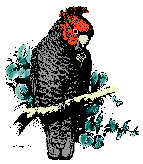 |
canberrabirds
|
 |
canberrabirds
|
| To: | "Philip Veerman" <> |
|---|---|
| Subject: | Yellow-tufted HE status. |
| From: | |
| Date: | Fri, 22 Jul 2005 10:18:21 +1000 |
|
Hi Philip, I appologise to everyone who has grown weary of this subject but will conclude my part of this debate on the status of the Yellow-tufted Honeyeater (YTHE) with one final broadside...(and I guess to also show how subjective status can be) Apart from the GBS Report stating the YTHE is "Uncommon" the following publications go even further. The "Birds of the Australian Capital Territory: An Atlas" by McComas Taylor and COG (1992 Reprint) states that the YTHE is a "Rare winter visitor" and "...are rarely encountered in the ACT." Then the "Field Guide to the Birds of the ACT" by McComas Taylor & Nicolas Day (1999) writes the species is to be expected in the ACT in winter and autumn and it shows a 'single binocular' icon for status - which the key states stands for "Very Rare. Expected once in one thousand visits or less." And the final say may go to the definitive updated guide to the avifauna of the ACT COG's "Annotated Checklist of the Birds of the Australian Capital Territory" compiled by David McDonald (2003) and based on "Birds of the ACT: Two Centuries of Change" by Steve Wilson OAM (1999). I have inserted the full description below:
I rest my case... Cheers Marnix
Hi Marnix, Thank you for the publicity. I knew full well what was in the GBS Report. I knew that it didn't say what you were quoting and I know that this text about some birds occurring more often in outer areas actually is in there for other species, so I was curious as to how those ideas came together. I knew that the GBS Report described that the bird is "uncommon" and in spite of clumsiness of all of these terms, that is ranking is consistent with the whole point I was making, which is that it is not "rare". I was lamenting that we don't have a word for something between "uncommon" and "rare". As for your further point that "The species in this list are ranked by No. of Records, and as we all know this can be deceiving, as the same bird or group of birds can be recorded many times." To clarify this. One record is a species at a site on a year. One record is one record whether it contains 52 observations of species presence (the maximum possible number) or one observation of species presence (the minimum possible number) and it is independent of abundance. Really I should have quoted the "A" value and given a level of greater detail, your comparisons on this are quite correct. These birds, like a lot of honeyeaters when they are in high densities, are very noisy and obvious but individual birds are much less obvious. I have no doubt that they are often around us in small numbers passing through and they just don't get noticed. I hope this is my last bit on this. Philip |
| <Prev in Thread] | Current Thread | [Next in Thread> |
|---|---|---|
| ||
| Previous by Date: | Isn't that the same guide?, Geoffrey Dabb |
|---|---|
| Next by Date: | Dusky Woodswallows, Lashko Susan |
| Previous by Thread: | Yellow-tufted HE status., Alastair Smith |
| Next by Thread: | Long-billed corellas, Nothrop |
| Indexes: | [Date] [Thread] [Top] [All Lists] |
The University of NSW School of Computer and Engineering takes no responsibility for the contents of this archive. It is purely a compilation of material sent by many people to the Canberra Ornithologists Group mailing list. It has not been checked for accuracy nor its content verified in any way. If you wish to get material removed from the archive or have other queries about the list contact David McDonald, list manager, phone (02) 6231 8904 or email . If you can not contact David McDonald e-mail Andrew Taylor at this address: andrewt@cse.unsw.EDU.AU